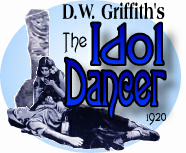

First National
CAST: Richard Barthelmess (Dan McGuire), Clarine Seymour (Mary, also known as White Almond Flower), George MacQuarrie (Rev. Franklyn Blythe), Creighton Hale (Walter Kincaid), Kate Bruce (Mrs. Blythe), Thomas Carr (Donald Blythe), Anders Randolph (the Blackbirder), Porter Strong (The Rev. Peter), Herbert Sutch (Old Thomas), Walter James (Chief Wando), Adolphe Lestina (black slave), Florence Short (Pansy), Ben Graver (native boy)
Petite and adorable, White Almond Flower is an island beauty
whose ancestry is described as "blood of vivacious France,
inscrutable Java and languorous Samoa..." Her temperament
is just as exotic: "A veritable savage though she keeps aloof
from the natives, wandering about lonely, shunning friendship
- a curious little creature of boldness, yet timidity." Although
she is a free spirit, she has allowed herself to be adopted by
a trader named Old Thomas.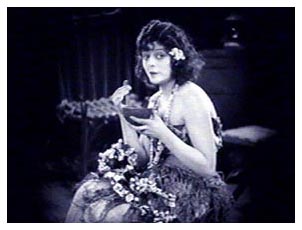
Wandering on the beach of her South Seas home one day, she literally runs across Dan McGuire, waterlogged, gin-soaked and passed out cold in the sand. Described as a "beachcomber," Dan is more of a "derelict thrown upon the shore by shifting waves and winds of many adventures." Although he regrets the course his life has taken, he begrudgingly accepts it with the help of the bottle and makes no effort to change.
White Almond Flower takes him home with her announcing to Old Thomas, "Daddy, shall we keep it or drown it?" Old Thomas retorts, "Drown it!" However, her father takes a liking to Dan. He is charmed by the Beachcomber's wild tales, which may or may not be true. A mutual affection also begins to develop between Dan and White Almond Flower.
Competition for White Almond Flower's affections arrives in the form of Walter Kincaid. He is the nephew of Rev. Blythe, a missionary on the island, trying his best to convert the natives to Christianity. Kincaid, a pasty-faced New Englander who is aptly described as "an invalid whose greatest moral offense has been kissing his cousin in a dark hallway," has come to the island to restore his health. In spite of his strict moral background, Kincaid soon develops a strong attraction for White Almond Flower. This vibrant island blossom takes advantage of the attentions of the two men, playing one drone against the other.
A frolic in paradise turns ugly thanks to a white fortune hunter referred to as "the Blackbirder." He and a native chief, Wando, keep a band of cannibalistic headhunters under their control by plying them with oceans of gin and liberal beatings. These cutthroats have heard rumors of a "catch of pearls" supposedly stored in the missionary's village.
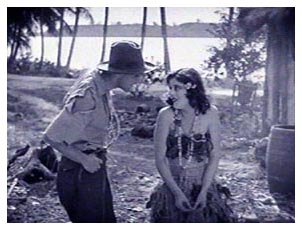 Christianity
vs. Paganism
Christianity
vs. PaganismAlthough not Christian, the Island pagans actively practice their spiritual life. Almond White Flower often goes to the ruins of a native house of idolatry. It is here where she suggestively dances in front of a wooden idol - just the kind of behavior the missionary is trying to put a stop to. The Blackbirder and Wando see her dancing and become inflamed with desire. They try to kidnap her, but don't realize the rivals for her affection, Kincaid and Dan, are also watching her from two different vantage points unbeknownst to each other. Wando retreats when he encounters Kincaid, who draws a gun, and Dan runs the Blackbirder off by threatening him with a knife.
Kincaid is soon scolded by Rev. Blythe for his interest in "that loose girl" who won't even wear the modest garb of Christian cloth to cover her body properly. In the ensuing verbal altercation, Kincaid has becomes so gravely ill it threatens to take his life. During the crisis, he continually asks to see White Almond Flower. The Reverend finally gives in and asks the pagan girl to visit his nephew. She brings Dan with her. Kincaid tells both of these heathens, "Remember, there IS something afterwards!" When Kincaid addresses Dan as "my brother," the drunken wretch is immediately touched by his compassion. Both he and White Almond Flower are so moved by Kincaid's sweet spirit, Dan renounces his atheism by throwing his gin into the ocean, and White Almond Flower renounces her paganism by throwing her beloved wooden idol in the churning waves.
The tides seem to turn for the better: Kincaid's health improves, and the Beachcomber surprises Old Thomas by asking him for work. The men of the village, including Dan and Old Thomas, leave in a boat on a fishing expedition. After they have paddled away, a native, whom the Blackbirder has savagely beaten, arrives in the village seeking refuge with the Rev. Blythe. The Blackbirder and Wando use the slave's escape as an excuse to raid the village. During the attack, all of the women, including White Almond Flower, seek protection in the Reverend's home - praying to be rescued before the Blackbirder's natives beat the door down and do their worst...
"The Idol Dancer" was the first of two successive
South Seas stories D.W. Grifffith made in 1920. (The other was
"The Love Flower" starring Barthelmess and  Carol
Dempsterr). Critic and historian Richard Schickel refers to "The
Idol Dancer" in D.W. Griffith - An American Life (Simon
and Schuster, 1984), as "ludicrous and lugubrious."
He also asserts that the films Griffith made for First National
are "the weakest in the Griffith canon."
Carol
Dempsterr). Critic and historian Richard Schickel refers to "The
Idol Dancer" in D.W. Griffith - An American Life (Simon
and Schuster, 1984), as "ludicrous and lugubrious."
He also asserts that the films Griffith made for First National
are "the weakest in the Griffith canon."
On the other hand, film historian Edward Wagenknecht, in The Movies and the Age of Innocence (University of Oklahoma Press, 1962), is somewhat kinder in his evaluation. While admitting the film's technical limitations, he says, "...the conflict between Christianity and paganism is a sound dramatic motif, the background and the native customs are colorful, and certainly Clarine's White Almond Blossom [sic] is good enough for any picture."
In retrospect, modern criticism of "The Idol Dancer" has probably been less than kind because the film is wedged between two of Griffith's masterpieces - "Broken Blossoms" (1919) and "Way Down East" (1920). Although contemporary reviews were mixed upon its initial release, all were complimentary of 20-year old Clarine Seymour's first lead role. "... Admirably acted by a well chosen cast, including Clarine Seymour, here seen at her prettiest, and recognized as the most charmingly photographic face," said Variety (March 26, 1920). "She plays the dramatic scenes with enough fire and sincerity almost to convince you that she is what she pretends to be, a dusky island belle," said Photoplay (June, 1920).
In 1917, the tiny beauty with huge dark eyes first appeared in films for the Thanhouser Company in New York and came west to work with Pathé in 1918. When Griffith discovered Clarine, she was working her way up the ladder via Christie comedies. The great director was casting for "The Girl Who Stayed at Home": (1919), with Barthelmess and Dempster, and selected her for a secondary role as "Cutie Beautiful." Griffith cast her with Lillian Gish and Bobby Harron in "True Heart Susie" (1919) and then with Barthelmess and Dempster again in "Scarlet Days" (1919) before giving her the female lead in "The Idol Dancer."
Unfortunately, Clarine was to live only one month after
the premier of "The Idol Dancer." She died in New York
on April 25, 1920, at 21 years of age. The details of her untimely
death are not clear. Some accounts report she died during an operation
for "strangulation of the intestines." Others say she
contracted pneumonia 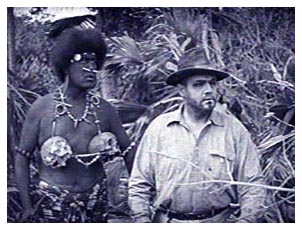 during her work on
Griffith's "Way Down East" while on location during
severe blizzard conditions. (She does not appear in the finished
film.) What is clear is she had just signed a four-year contract
for a whopping two million dollars.
during her work on
Griffith's "Way Down East" while on location during
severe blizzard conditions. (She does not appear in the finished
film.) What is clear is she had just signed a four-year contract
for a whopping two million dollars.
Clarine Seymour was one of the best and brightest. She was poised on the precipice of stardom when she met her untimely death. Wagenknecht, in The Films of D.W. Griffith (Crown Publishers, Inc, 1975), speculates that, had Clarine lived, she would have become "an important star," noting that "She would have suited the screen in the twenties." Anthony Slide, in The Griffith Actresses (A.S. Barnes and Co., 1973), goes a step further and speculates that she could have made Griffith's final films "as great as his earlier works." Whatever the future may have held had she lived, it is obvious from viewing her engaging and inspired performance in "The Idol Dancer" that her death was a great loss to the cinema.
Richard Barthelmess' convincing performance as the wasted beachcomber Dan McGuire was a far cry from a role he would make famous the next year -- that of the boyish hero in "Tol'able David" (1921). Barthelmess' character is complex -- a career atheist/drunkard/derelict who is miraculously reformed by the love and kindness of his rival. In Dan McGuire, we are given a character who, while being stubborn and hard in his alcoholism and atheism, is a sensitive man who regrets his present condition but doesn't know how to change it. Wagenknecht said, "Richard Barthlmess turns in an excellent characterization in a very uncharacteristic role."
Creighton Hale was perfectly cast as the sickly Walter Kincaid. He, too, gives a convincing performance, and we get a sincere portrayal of a man who is firm in his faith, yet helplessly enchanted by the beautiful White Almond Flower; suffering from illness, yet able to fight and sacrifice for others; and although we intuitively know Barthelmess will get the girl in the end, Hale's Walter Kincaid is a believable rival for the island girl's affection.
Hale appeared in over 50 films during the silent era, and, although he obviously was much in demand, he never attained star status. He can be seen at his best in Ernst Lubtisch's "The Marriage Circle" (1924) in which he holds an almost teenage boyish lovesick fixation with another man's wife while being timid and frightened that anyone would find out, especially the husband, of course. (See "The Marriage Circle" as our "Feature of the Month") Little Rascals fans may remember him as Miss Crabtree's brother in "School's Out" (1930). Hale continued to work in films beyond the silent era, appearing in over 250 films between 1914 and 1959.
Griffith knew the value of comedic interludes to keep drama
from becoming too heavy-handed, but, in "The Idol Dancer,"
the comedy doesn't work very well. Porter Strong in black face
as "Peter," the first native convert and Rev. Blythe's
assistant, and Florence Short (also in black face) as another,
less committed convert, "Pansy," are intended to provide
several humorous interludes in the story, but the humor is corny,
to say the least. Pansy shimmies and shakes as if she is having
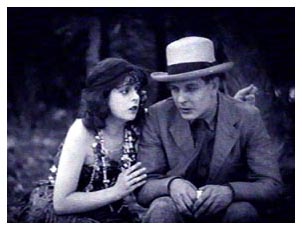 convulsions every time she gets near a man.
What conversion has taken place in her is questionable. Peter's
conversion appears to be based on his desire to strut around in
a frock coat and lenseless glasses with Bible in hand imitating
his white mentor.
convulsions every time she gets near a man.
What conversion has taken place in her is questionable. Peter's
conversion appears to be based on his desire to strut around in
a frock coat and lenseless glasses with Bible in hand imitating
his white mentor.
Somewhat more entertaining, in a "cute" sort of way, is Thomas Carr as Rev. Blythe's son trying to get Ben Grauer, as the native boys, to wear pants instead of a loin cloth. The boys actually come to blows over this, and, although incidental to our main story, it appears Griffith is giving us something to think about - for example, what really is right or wrong? To the native boy, his revealing loin cloth is perfectly natural, a part of his culture, while the white boy, in line with his culture, sees it as sinful.
The print reviewed here is a discontinued release of "The Idol Dancer" once made available by Critic's Choice Video. The picture quality is good throughout, however, the same cannot be said concerning the musical score.
The Killiam Library, providers of the print used for this video, was eager to provide a score that would help silent films appeal to modern audiences. The video's packaging states, "This silent classic features a new music score by the world-renowned musician and composer who has virtually reinvented the silent film score, Jim Roberge." Whatever the artistic merits of Mr. Roberge, the musical accompaniment was not only inappropriate, but downright distracting in some sequences. The pace and instrumentation of this music did not match the emotion of the scenes. Electric guitars, electric keyboards and very strong bass and drums make up the bulk of the film's musical score. Long stretches, up to 10 minutes, of a repetitive drum beat do not qualify, in this reviewer's opinion, as "musical accompaniment." The least egregious part of the score is the occasional sound of steel drums which give an island flavor (never mind that steel drums are to be found in the Caribbean, not the South Seas). Unfortunately, the musical accompaniment mostly detracts rather than adds to the enjoyment of this film.
copyright 2005 by Tim Lussier; all rights reserved.